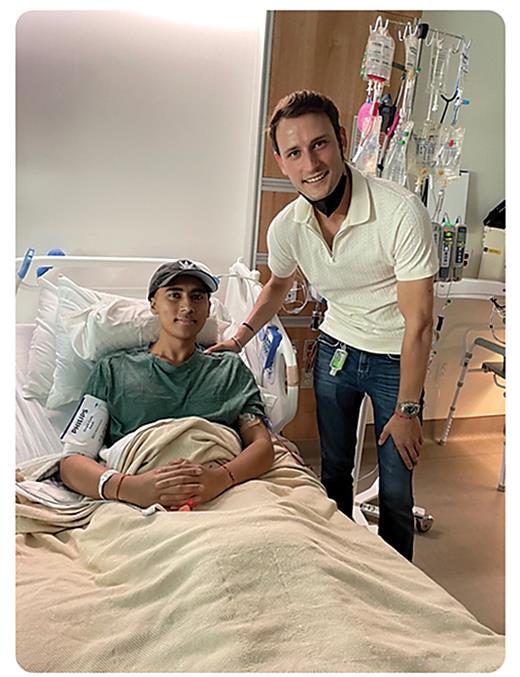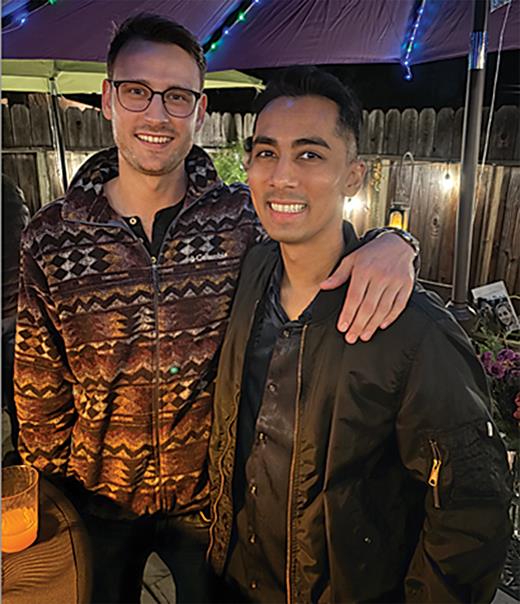I first met Rohan in early 2024. During our initial clinic visit, he immediately stood out as smart, respectful, kind — and palpably anxious. One month earlier, at the age of 27, he had received a diagnosis of acute myeloid leukemia (AML). Just weeks before, he had been working toward a big promotion at his dream job in the tech industry. By the time we met, Rohan was already well informed: he understood the mutations associated with his leukemia, had completed induction chemotherapy, and arrived with a printout outlining the statistical benefit of undergoing allogeneic transplant in first complete remission (CR) for his specific AML subtype. We discussed his diagnosis in depth, reviewed the process of transplant, and spoke candidly about the potential risks and benefits. As we said goodbye, I asked him the question I pose to all my new patients: “Would you like to meet someone who has gone through a transplant?”
In 2023, Matt, another patient of mine, was 25 years old. He was articulate, bright, charismatic, beginning a career in sales, and excited about young adulthood. What started as a prolonged upper respiratory infection led to life-altering news: he had FLT3-mutated AML. He underwent induction therapy, followed by consolidation, and although he achieved CR, measurable residual disease (MRD) persisted despite treatment with various FLT3 inhibitors. Matt was adopted as a baby and, unexpectedly, his human leukocyte antigen (HLA) typing revealed highly unique HLA genetics. With no suitable HLA matched or mismatched related or unrelated donors, he underwent a myeloablative double cord blood transplant in the summer of 2023. His initial recovery was challenging, marked by weight loss, mild skin graft-versus-host disease (GVHD), and viral reactivations. By early 2024, Matt was gaining strength, tapering off transplant-related medications, and in a deep remission with undetectable MRD.
Matt clearly remembers the moment he was asked if he would be willing to connect with Rohan to offer peer mentorship and support. During his own treatment the year prior, Matt had the chance to speak with another young adult, Nick, who had undergone a haploidentical transplant for FLT3-mutated AML. His conversations with Nick had been incredibly comforting. So, Matt didn’t hesitate when his care team reached out and said, “Hey, we have somebody who is right around your age with a similar diagnosis. Would you be willing to talk to him?” This was the first time since his diagnosis that Matt felt he could truly be helpful to someone else.
Rohan texted Matt immediately after receiving his cell number, and they met in person soon afterwards. Of their first meeting, Rohan recalls, “After induction — I think for a lot of people — you lose a significant amount of weight. My hair was gone. And I was just like, alright, I need to see a product of success here, specifically someone who’s younger. And he [Matt] looked very, very normal to me. And that is just what I wanted so badly — normalcy again. So, I think that alone meant the world to me.”
While planning for transplant, Rohan’s leukemia relapsed. As he fought to regain remission, it also became clear that he, too, had a unique HLA type and would not have a suitable living related or unrelated transplant donor. Matt said that being there for Rohan through his relapse brought him comfort but stirred up other feelings, too. “I do remember having some anxiety come back, around whether this might happen to me,” Matt said. “And I was truly scared for him as well. We just became a tight team, and we were in this together. So, there was that legitimate fear, but I would say that it’s well worth it, in my opinion. This was a situation that came from a really unfortunate disease but turned into … one of the greatest friendships that I’ve had.”
When Rohan, who is Indian American, learned that his only available stem cells would also be from cord blood units, he said he initially thought, “Maybe the world is so unfair to have cancer, but then to also be a person of color [and not have available donors] and to get that other hit as well — it just started to feel like, okay, there are going to be people who survive this just because of their racial background.” When I asked him about the impact of knowing that Matt had gone through the same experience, he said, “But then with Matt [who is white], no one’s sitting there thinking he had no matches at all, or that he needed a cord blood transplant. And if he could do it, then I could do it too. So, it almost blocked out that really bad disadvantage in life.”
Matt, right, visits Rohan during his cord blood stem cell infusion.
Matt, right, visits Rohan during his cord blood stem cell infusion.
One day in July 2024, I received a photo and text message from Matt. Rohan was receiving his cord blood stem cells, and Matt was right there beside him, cheering him on. (“Just a couple of guys with baby blood convincing people we’re adults,” Matt quipped in his text.) Nine and a half months have passed since that day. Following transplant, Rohan shared Matt’s early struggles of weight loss, skin GVHD, and viral reactivations. And we had an MRD scare, which thankfully resolved. Today, Rohan has gained back the weight, and his hair, and he’s pivoting his career toward a position to help other young adults. Matt, meanwhile, is engaged, has a new puppy, and was recognized as a 2024 Leukemia and Lymphoma Society Honored Hero. Rohan is set to receive this same award in 2025.
As quantitative and qualitative research suggest,1-4 peer connection is not only effective but often an essential component of the leukemia and transplant journey. For clinicians interested in facilitating peer connections, Matt advises asking patients early on whether they would like to talk to someone of a similar age and diagnosis who is doing well. He also recommends training programs for peer mentors, which are often available through patient advocacy organizations or some institutions. And when a formal program isn’t available? I recommend a good matchmaker, which I am fortunate to have in my clinic nurses.
I was privileged to host a recent episode of The Hematologist podcast with Rohan and Matt. At the conclusion of our conversation, I asked them to reflect on what their relationship through AML has meant to one another. Here’s an excerpt of their comments:
Rohan: “Matt, we both ran track, and somehow you ended up passing me the baton this time — not on the field — but in life. We both found the odds stacked by a system that wasn’t fully built for us, but still, there was a path. Even when I began to disappear undergoing chemo and radiation, when I couldn’t recognize what was left of me, you and my doctor saw my new life ahead. And that was all I needed. Now, I’ve found the path forward, and I’m running with it.”
Matt: “Rohan, they say that cancer is one of the worst ways to meet some of the best people, and I can certainly say that you are one of the best people I’ve met along this journey. I knew what you were up against and what it would take to overcome it. So, when I was asked if I would be willing to meet with you and offer any advice that I might have, I jumped at the opportunity. It would be the first time in my own treatment journey that I would feel useful again. As you probably know, parts of your identity and purpose become lost through this type of life event. To have a chance to add hope to someone else’s life is an amazing thing. I hope that our story helps future patients see the true value of peer mentorship. The truth is that cancer is scary and leaves people with so many unknowns in their life. But the simple connection of a fellow survivor willing to listen and empathize truly does make all the difference. Thank you for being that person for me.”
Rohan and Matt’s friendship — and the countless other peer-to-peer supports I have witnessed over the years — shines a bright light during a dark and difficult time. Listening to their heartfelt and deeply moving responses, I was reminded of the profound privilege of being a leukemia and transplant doctor — which allows me to witness the very best of human connection, and of humanity itself.
Matt and Rohan, pictured post-treatment, say they have helped one another find a path forward.
Matt and Rohan, pictured post-treatment, say they have helped one another find a path forward.
Disclosure Statement
Dr. Muffly indicated no relevant conflicts of interest.


